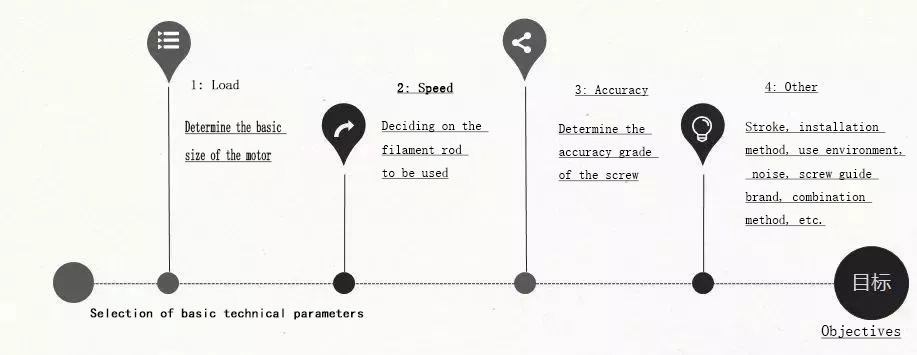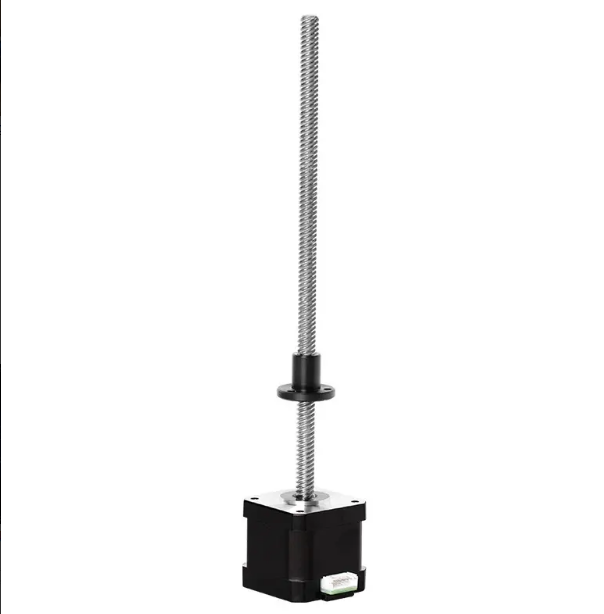Motore passo-passo lineare, noto anche comemotore passo-passo lineare, è un nucleo di rotore magnetico che interagisce con il campo elettromagnetico pulsato generato dallo statore per produrre la rotazione, un motore passo-passo lineare al suo interno converte il moto rotatorio in moto lineare. I motori passo-passo lineari possono generare direttamente un moto lineare o un moto alternativo lineare. Se si utilizza un motore rotativo come fonte di energia per convertire il moto in moto lineare, sono necessari ingranaggi, strutture a camme e meccanismi come cinghie o fili. La prima introduzione dei motori passo-passo lineari risale al 1968 e la figura seguente mostra alcuni tipici motori passo-passo lineari.

Principio di base dei motori lineari azionati esternamente
Il rotore di un motore passo-passo lineare azionato esternamente è un magnete permanente. Quando la corrente scorre attraverso l'avvolgimento dello statore, quest'ultimo genera un campo magnetico vettoriale. Questo campo magnetico fa ruotare il rotore di un certo angolo, in modo che la direzione della coppia di campi magnetici del rotore coincida con la direzione del campo magnetico dello statore. Quando il campo magnetico vettoriale dello statore ruota di un angolo, anche il rotore ruota di un angolo con questo campo magnetico. Per ogni impulso elettrico in ingresso, il rotore elettrico ruota di un angolo e si muove di un passo in avanti. Produce uno spostamento angolare proporzionale al numero di impulsi in ingresso e una velocità proporzionale alla frequenza degli impulsi. Modificando l'ordine di eccitazione degli avvolgimenti, il motore si inverte. Pertanto, la rotazione del motore passo-passo può essere controllata controllando il numero di impulsi, la frequenza e l'ordine di eccitazione degli avvolgimenti del motore di ciascuna fase.
Il motore utilizza una vite come asse di uscita e un dado di azionamento esterno è innestato nella vite esternamente al motore, impedendo in qualche modo alla madrevite di ruotare l'una rispetto all'altra, ottenendo così un movimento lineare. Il risultato è un design notevolmente semplificato che consente l'uso diretto di motori passo-passo lineari per un movimento lineare preciso in molte applicazioni, senza l'installazione di un collegamento meccanico esterno.
Vantaggi dei motori lineari azionati esternamente
I motori passo-passo lineari di precisione possono sostituire i cilindri inalcune applicazioni, ottenendo vantaggi quali posizionamento preciso, velocità controllabile ed elevata accuratezza. I motori passo-passo lineari a vite sono utilizzati in un'ampia gamma di applicazioni, tra cui produzione, calibrazione di precisione, misurazione di precisione dei fluidi, movimento di posizione preciso e molti altri settori con requisiti di elevata precisione.
▲Alta precisione, precisione di posizionamento ripetibile fino a ±0,01 mm
Il motore passo-passo a vite lineare riduce il problema del ritardo di interpolazione grazie al semplice meccanismo di trasmissione, alla precisione di posizionamento, alla ripetibilità e all'accuratezza assoluta. È più facile da ottenere rispetto al "motore rotativo + vite". La precisione di posizionamento ripetuto della vite ordinaria del motore passo-passo a vite lineare può raggiungere ±0,05 mm, mentre la precisione di posizionamento ripetuto della vite a sfere può raggiungere ±0,01 mm.
▲ Alta velocità, fino a 300 m/min
La velocità del motore passo-passo a vite lineare è di 300 m/min e l'accelerazione è di 10 g, mentre la velocità della vite a sfere è di 120 m/min e l'accelerazione è di 1,5 g. La velocità del motore passo-passo a vite lineare sarà ulteriormente migliorata dopo aver risolto con successo il problema del calore, mentre la velocità del "servomotore e vite a sfere" è limitata, ma è difficile migliorarla ulteriormente.
Lunga durata e facile manutenzione
Il motore passo-passo a vite lineare è adatto per un'elevata precisione poiché non vi è alcun contatto tra le parti mobili e quelle fisse grazie allo spazio di montaggio e non vi è usura dovuta al movimento alternativo ad alta velocità dei motori. La vite a sfere non può garantire la precisione nel movimento alternativo ad alta velocità e l'attrito ad alta velocità causerà l'usura della madrevite, che influirà sulla precisione del movimento e non soddisferà i requisiti di elevata precisione.
Selezione del motore lineare con azionamento esterno
Quando si realizzano prodotti o soluzioni correlati al movimento lineare, suggeriamo agli ingegneri di concentrarsi sui seguenti punti.

1. Qual è il carico del sistema?
Il carico del sistema comprende il carico statico e il carico dinamico e spesso la dimensione del carico determina la dimensione di base del motore.
Carico statico: la spinta massima che la vite può sopportare a riposo.
Carico dinamico: la spinta massima che la vite può sopportare quando è in movimento.
2. Qual è la velocità lineare di funzionamento del motore?
La velocità di rotazione del motore lineare è strettamente correlata al passo della vite: un giro della vite equivale a un passo della chiocciola. Per basse velocità, si consiglia di scegliere una vite con un passo più piccolo, mentre per alte velocità, si consiglia di scegliere una vite con un passo più grande.
3. Qual è il requisito di precisione del sistema?
Precisione della vite: la precisione della vite è generalmente misurata dalla precisione lineare, vale a dire l'errore tra la corsa effettiva e la corsa teorica dopo che la vite ha ruotato per un cerchio asciutto.
Precisione di posizionamento ripetuto: la precisione di posizionamento ripetuto è definita come la precisione del sistema nel raggiungere ripetutamente la posizione specificata, il che è un indicatore importante per il sistema.
Gioco: gioco della vite e della chiocciola a riposo quando i due assi sono in movimento relativo. Con l'aumentare del tempo di lavoro, anche il gioco aumenterà a causa dell'usura. La compensazione o la correzione del gioco può essere ottenuta con la chiocciola di eliminazione del gioco. Quando è richiesto un posizionamento bidirezionale, il gioco è un problema.
4. Altre selezioni
Nel processo di selezione è necessario considerare anche i seguenti aspetti: il montaggio del motore passo-passo lineare è conforme al progetto meccanico? Come verrà collegato l'oggetto in movimento al dado? Qual è la corsa effettiva della vite? Quale tipo di azionamento verrà abbinato?

Data di pubblicazione: 16-11-2022
